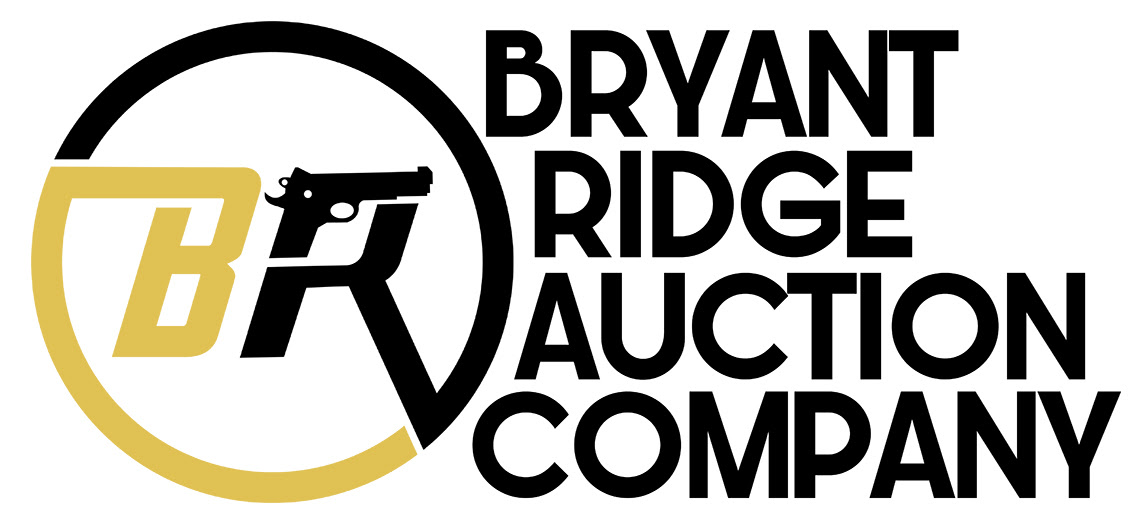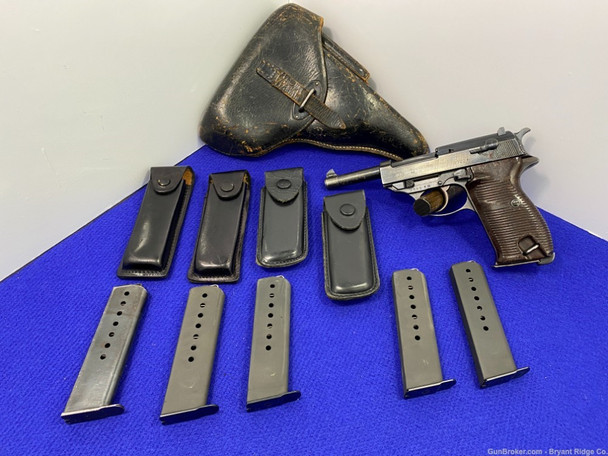Description

Item Description
Bryant Ridge Auction Company is pleased to present this WWII semi-auto pistol today for a penny start auction, this is the Walther P.38!
SPECIFICATIONS:
Manufacturer: Walther
Model: P.38
Serial: 2322F
Date of Manufacture: 1943
Caliber: 9mm Parabellum
Finish: Blue
Barrel Length: 5"
Optics/Sights: Dovetail Blade Front and Fixed Notch Rear
Stock/Grips: Serrated Bakelite
Action: Semi-Auto
Markings: Standard / Import Marks
Bryant Ridge's Analysis:
As you can see in the many high resolution photos, this Walther is in Excellent condition overall showing what we believe to be much less than average evidence use that is indicative of these models. Additionally, it will ship with the leather holster, 4 leather magazine holsters, and a total of 6 magazines.
Return Policy:
We gladly offer a 3 day unfired inspection policy from the time that the firearm is delivered to your FFL. Refunds are available for all qualifying orders.
Model: P.38
Serial: 2322F
Date of Manufacture: 1943
Caliber: 9mm Parabellum
Finish: Blue
Barrel Length: 5"
Optics/Sights: Dovetail Blade Front and Fixed Notch Rear
Stock/Grips: Serrated Bakelite
Action: Semi-Auto
Markings: Standard / Import Marks
Bryant Ridge's Analysis:
The Walther P38 (originally written Walther P.38) is a 9 mm semi-automatic pistol that was developed by Carl Walther GmbH as the service pistol of the Wehrmacht at the beginning of World War II. It was intended to replace the costly Luger P08, the production of which was scheduled to end in 1942.
During WWII, the P.38 was produced by three separate manufacturers: Walther, Mauser, and Spreewerk. To conceal manufacturer identities, each wartime manufacturer used a letter code: ac (Walther); byf (Mauser), and cyq (Spreewerk), followed by the date (e.g.: ac44: Walther 1944 production). Spreewerk did not mark production dates. Pistols were produced in blocks of 10,000 consecutively numbered pistols, with each block having a consecutive letter suffix, to conceal production volume. 1,277,680 P.38s were produced during WWII: 617,585 by Walther in Zella-Mehlis; 372,875 by Mauser in Oberndorf; 287,220 by Spreewerk Grottau. Late in the war, the Spreewerk cyq die broke. Subsequent pistols appear to be marked "cvq" due to the broken die. About 31,400 pistols are so marked. Spreewerk production ended April 1945.
After the war from 1945-1946, several thousands of pistols were assembled for the French armed forces (frequently dubbed "grey ghosts" because of parkerized finish and grey sheet metal grips). Only after 1957 was the P38 again produced for the German military. Slowly over time, West Germany desired to rebuild its military so that it could shoulder some of the burden for its own defense. Walther retooled for new P38 production since no military firearms production had occurred in West Germany since the end of the war, knowing that the military would again seek Walther firearms. When the Bundeswehr announced it wanted the P38 for its official service pistol, Walther readily resumed P38 production within just two years, using wartime pistols as models and new engineering drawings and machine tools. The first of the new P38s were delivered to the West German military in June 1957, some 17 years and two months after the pistol had initially seen action in World War II, and from 1957 to 1963 the P38 was again the standard sidearm.
Condition and Contents:The Walther P.38 was in production from 1939 to 1945. Initial development of the pistol took place 1937-1939, culminating in the first model, designated Model HP or Heerespistole ("army pistol"), which had several variants as engineering changes were made. Early production included a Swedish contract. The designation P.38 indicates Wehrmacht adoption in 1938, although the exact date is unknown. The transition from HP to the mechanically-identical P.38-marked pistols took place 1939-1940. Sweden bought the P38 in 1939.
During WWII, the P.38 was produced by three separate manufacturers: Walther, Mauser, and Spreewerk. To conceal manufacturer identities, each wartime manufacturer used a letter code: ac (Walther); byf (Mauser), and cyq (Spreewerk), followed by the date (e.g.: ac44: Walther 1944 production). Spreewerk did not mark production dates. Pistols were produced in blocks of 10,000 consecutively numbered pistols, with each block having a consecutive letter suffix, to conceal production volume. 1,277,680 P.38s were produced during WWII: 617,585 by Walther in Zella-Mehlis; 372,875 by Mauser in Oberndorf; 287,220 by Spreewerk Grottau. Late in the war, the Spreewerk cyq die broke. Subsequent pistols appear to be marked "cvq" due to the broken die. About 31,400 pistols are so marked. Spreewerk production ended April 1945.
After the war from 1945-1946, several thousands of pistols were assembled for the French armed forces (frequently dubbed "grey ghosts" because of parkerized finish and grey sheet metal grips). Only after 1957 was the P38 again produced for the German military. Slowly over time, West Germany desired to rebuild its military so that it could shoulder some of the burden for its own defense. Walther retooled for new P38 production since no military firearms production had occurred in West Germany since the end of the war, knowing that the military would again seek Walther firearms. When the Bundeswehr announced it wanted the P38 for its official service pistol, Walther readily resumed P38 production within just two years, using wartime pistols as models and new engineering drawings and machine tools. The first of the new P38s were delivered to the West German military in June 1957, some 17 years and two months after the pistol had initially seen action in World War II, and from 1957 to 1963 the P38 was again the standard sidearm.
As you can see in the many high resolution photos, this Walther is in Excellent condition overall showing what we believe to be much less than average evidence use that is indicative of these models. Additionally, it will ship with the leather holster, 4 leather magazine holsters, and a total of 6 magazines.
Return Policy:
We gladly offer a 3 day unfired inspection policy from the time that the firearm is delivered to your FFL. Refunds are available for all qualifying orders.
Shipping Details
Handgun Standard Shipping $50.00
Long Gun Standard Shipping $65.00
We strive to ship orders within the close of the following business day after payment and documentation is received.
Payment Details
We accept all forms of Payment including Personal Check, Business Check, PO Money Orders, Certified Check, Etc.
Please note we place a 7 business day hold on shipment, for all non-certified payments.
Return Policy
We gladly offer a 3 day unfired inspection policy from the time that the firearm is delivered to your FFL. Refunds are available for all qualifying orders.
Additional Details
Our #1 priority is customer satisfaction. We want to build a lasting trust in the relationship with our customers, so that you will always look to us for all your firearms needs. If you have any issues with your transactions please contact us, and we will work with you to resolve any issues you may have. We greatly appreciate your trust in us and we look forward to fulfilling all your future firearm needs.
Bryant Ridge also reserves the right to cancel any sales that may occur while gunbroker.com is experiencing technical issues that affects the entire site or a complete site outage, within an hour of the auction ending.
We have an amazing inventory of classic and collector firearms that we are adding to Gunbroker daily. Stay up to date on all of our latest auction by adding us to your favorite sellers list.
About Us
From a small town hobby, to a leader in the investment and collector grade firearms industry. Bryant Ridge Firearms is here to offer the best in quality and customer service when you are looking to unload your collector grade firearm collection.
















